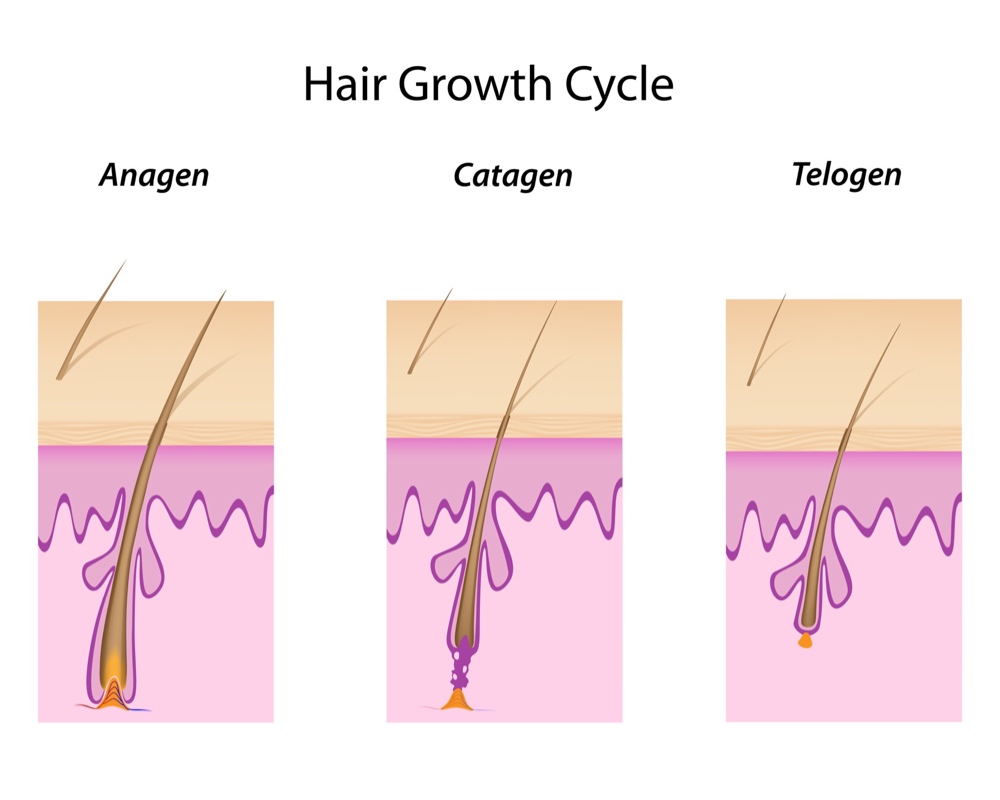Hair follicles have a cyclic growth pattern that produces hair strands with a predetermined life span. A healthy hair growth cycle means healthy hair, that completes its lifespan and is not at risk of premature shedding.
Composition of hair
Human hair comprises of two distinct parts: the follicle and the shaft.
- The hair follicle is the part that anchors the hair into the scalp. There are more than 100,000 hair follicles on the scalp alone, and approximately five million hair follicles on the rest of the body. The follicle itself is composed of the dermal papilla and the hair bulb, both of which reside beneath the scalp. The papilla receives the blood through tiny capillaries, and then proceeds to provide nourishment to the rest of the hair. The bulb on the other hand consists of the most actively dividing cells found in the body, and is where the hair actually originates.
- The hair shaft is the dead cells that form the visible hair strand coming out of the hair follicle. The shaft is composed of a protein called Keratin which has a protective layer known as the cuticle.
How does the hair growth cycle work?
The hair growth cycle has three distinct and concurrent phases: the Anagen phase, the Catagen phase, and the Telogen phase. Some publications also acknowledge the presence of a fourth stage called the Exogen phase.

Anagen (Growth) Phase
The anagen is the first and the most active phase of the hair growth cycle. During the anagen phase, cells at the base of the follicle divide rapidly, resulting in new hair. The new growing hair pushes any club hair (i.e. hair in a dormant state of growth) out of the follicle. 80-90% of hair follicles are in the anagen phase at any given time. During this phase, hair is estimated to grow approximately 1 cm every 28 days or six inches annually, with hair growing more rapidly in summers than in winters. Similarly, ethnicity and race also play a significant role in determining the length of the anagen phase, for instance, a longer anagen phase is observed in people of Asian descent. Other factors affecting the duration of the anagen phase include genetics, age, general health, hormonal and nutritional status, etc.
The anagen phase lasts somewhere between two to six years and its duration determines the maximum hair length that is achieved with each hair cycle. For example, individuals facing difficulty growing hair beyond a certain length have a shorter anagen phase in comparison to others with longer hair. This is also the reason why hair around eyelashes, eyebrows, and other body hair is shorter, in relation to scalp hair, as their anagen phases are significantly shorter (about 30 to 45 days) than the latter.
Catagen (Transition) Phase
The catagen or the transitional phase, follows the anagen phase and can last around 2-3 weeks at maximum. In this phase the hair follicle shrinks and detaches itself from the dividing dermal papilla, forming the club hair. As the detachment cuts off any blood supply, the club hair has no ability to elongate any further. At any given time 3% of hair is present in the catagen phase.
Telogen (Resting) Phase
The telogen or the resting phase, follows the catagen phase and is where the hair follicles remain dormant for the next hair cycle. The first sign of catagen is the cessation of melanin production in the hair bulb and the self-destruction of follicular melanocytes. At any given time around 10-15% of hairs are in this phase. Telogen phase is estimated to last for about 100 days for hairs on the scalp, and longer for hairs on other parts of the body.
Exogen (New Hair) Phase
Many publications consider it a part of the resting phase where the old hair sheds, and the follicles are activated again. Approximately 50 to 150 hairs are reported to fall out on a daily basis, representing the exogen phase. The hair growth cycle starts again after the hair shedding observed in the exogen phase.
REFERENCES:
Peus D, Pittelkow MR. Growth factors in hair organ development and the hair growth cycle. Dermatologic clinics. 1996 Oct 1;14(4):559-72.
Mak KK, Chan SY. Epidermal growth factor as a biologic switch in the hair growth cycle. Journal of Biological Chemistry. 2003 Jul 11;278(28):26120-6.
Schneider MR, Schmidt-Ullrich R, Paus R. The hair follicle as a dynamic mini-organ. Current Biology. 2009 Feb 10;19(3):R132-42.
Harkey MR. Anatomy and physiology of hair. Forensic science international. 1993 Dec 1;63(1-3):9-18
In Elzouki, Abdelaziz Y.; Harfi, Harb A.; Nazer, Hisham M.; Stapleton, F. Bruder; Oh, William; Whitley, Richard J. (eds.). Textbook of Clinical Pediatrics. pp. 1489–508.
Braun-Falco, Otto (2000). Dermatology (2., completely rev. ed.). Berlin: Springer. p. 1101.
Araújo R, Fernandes M, Cavaco-Paulo A, Gomes A. Biology of human hair: know your hair to control it. InBiofunctionalization of Polymers and their Applications 2010 (pp. 121-143). Springer, Berlin, Heidelberg.
Messenger AG. The control of hair growth: an overview. Journal of investigative dermatology. 1993 Jul 1;101(1):S4-9.
Peus D, Pittelkow MR. Growth factors in hair organ development and the hair growth cycle. Dermatologic clinics. 1996 Oct 1;14(4):559-72.
Mak KK, Chan SY. Epidermal growth factor as a biologic switch in hair growth cycle. Journal of Biological Chemistry. 2003 Jul 11;278(28):26120-6.
Bernard BA. Advances in understanding hair growth. F1000Research. 2016;5.
